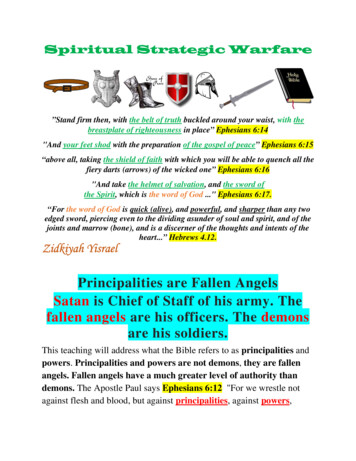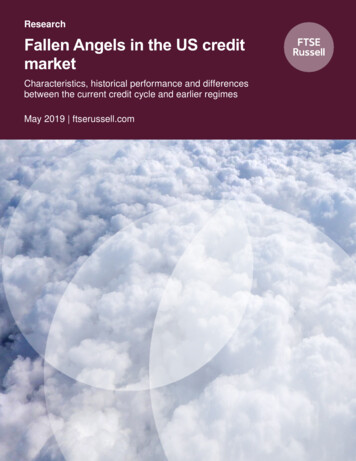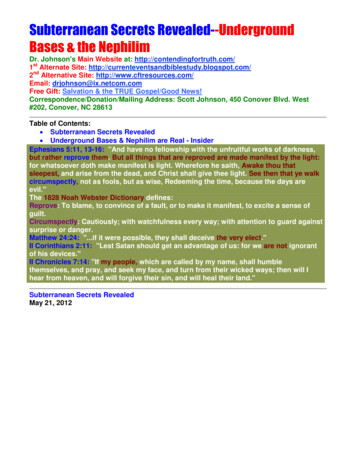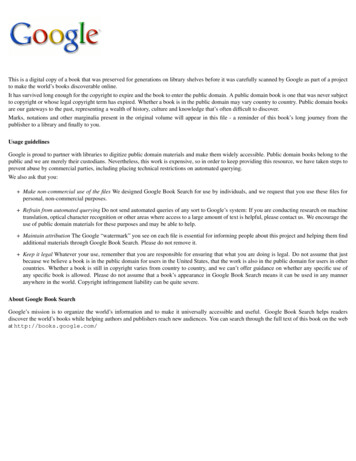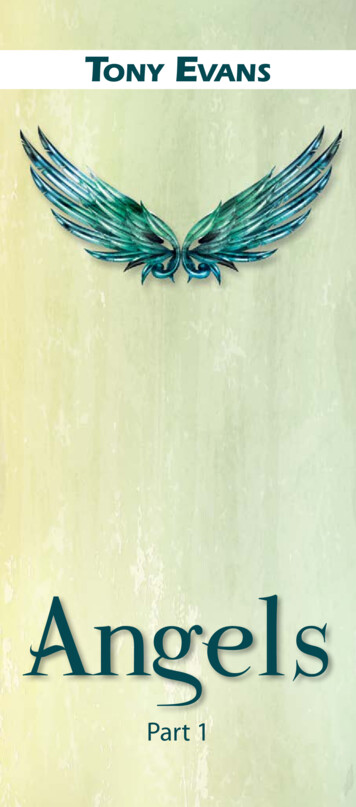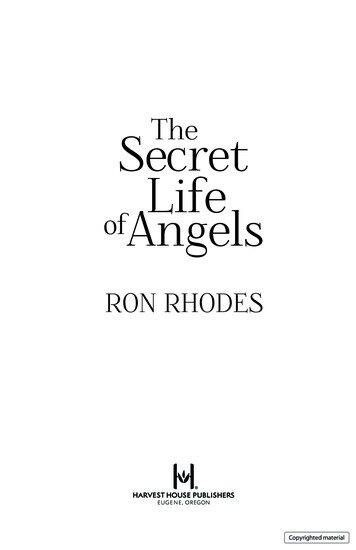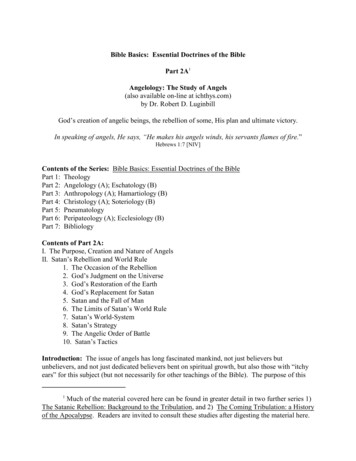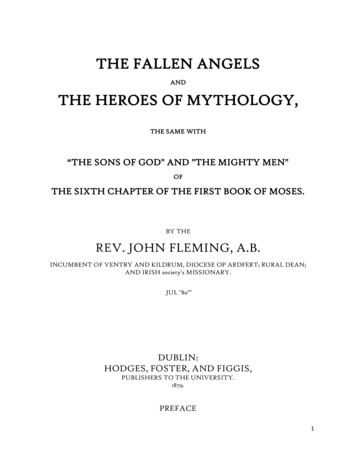
Transcription
THE FALLEN ANGELSANDTHE HEROES OF MYTHOLOGY,THE SAME WITH“THE SONS OF GOD" AND "THE MIGHTY MEN"OFTHE SIXTH CHAPTER OF THE FIRST BOOK OF MOSES.BY THEREV. JOHN FLEMING, A.B.INCUMBENT OF VENTRY AND KILDRUM, DIOCESE OP ARDFERT; RURAL DEAN;AND IRISH society's MISSIONARY.JUL "80”'DUBLIN:HODGES, FOSTER, AND FIGGIS,PUBLISHERS TO THE UNIVERSITY.1879.PREFACE1
The passage of Holy Scripture which the writer of the following pagesendeavours to elucidate, is one on which a large amount of labour has beenexpended, and no inconsiderable share of learning and ingenuity employed, byBiblical interpreters, in ancient, mediaeval, and modem times, in order toascertain and exhibit its meaning. From the commencement of our era, at least,no century has elapsed, in which it has not, in some shape, been explained orcommented on. Jewish and Christian theologians, in the east and in the west,have offered, in the form of commentary, or paraphrase, or translation,interpretations of the passage, according to their respective views: while writersof history, in the middle ages, have embodied, in their works, a widely-receivedversion of the brief narrative which it contains. The opinions which have beenpropounded on the subject, are, as might be expected, various: and the languagesin which these have been expressed, are many — Hebrew, Chaldee, Syriac,Ethiopic, Arabic, Greek, Latin, German, French, and English, being included inthe number. The view which the present writer adopts, from a full convictionthat it is the only admissible one, has been deemed not merely absurd, butimpious and heretical, and is still regarded by many as, at the least, fanciful, andby some, it is to be believed, with a feeling of aversion so strong, that theyavoid even an allusion to it, no doubt, lest they should appear to give it even asmall measure of countenance.The opinions entertained, respecting the meaning of the passage, byJewish and Christian writers, in ancient and mediaeval times, as well as by theprincipal modern commentators, are noticed in the following pages. The ablesttreatise on the subject, and the most exhaustive of it, with which the writer isacquainted, is that by John Henry Kurtz, D.D., Professor of Theology atDorpat, entitled, "Die Ehen der Sohne Gottes mit den Tochtern derMenschen;” Berlin, 1857, 8vo., pp. 100 — and advocating, for the most part,views similar to those here advanced. Dr. Kurtz’s book was written in reply toan essay by Professor Dr. G. F. Keil, bearing a somewhat similar title, butassailing the opinions already propounded on the subject by the former, in hisHistory of the Old Covenant, and contending for a different interpretation ofthe passage. Dr. Keil's treatise appeared in the "Zeitschrift fiir die lutherischeTheologie und Kirche,” 1855 PP« 220-56: and of its author. Dr. Kurtz says that,"Of all the supporters of his (Keil’s) view, there is not one who has treated thesubject so thoroughly and comprehensively — has brought to the investigationof it so much diligence, acuteness, and learning — has so carefully arranged and2
exhibited the arguments which may be advanced in its favour, and hasendeavoured with so much earnestness, and so much appearance of success, tooverthrow those which are brought forward on the opposite side."These two divines may be regarded as able representatives of the holdersof their respective views: and, indeed, had an English translation of ProfessorKurtz's book appeared, there would be little pretext for the present publication,although differing considerably from it, as well in point of matter, as in thearrangement and treatment of the several parts of the subject. Dr. Keil has,besides, devoted to the examination of the passage a section of twelve pages(137-139) in his Commentary on the Pentateuch, a work which has beentranslated into English, and forms three volumes of that valuable and importantseries, the Foreign Theological Library of Messrs. T. & T. Clark.Of the works mentioned, and especially of Kurtz's “Die Ehen,” &c.,much use has been made, as well as, of Maitland's Essay on “False Worship,”(Lond. 1856.) and that on "The Fallen Angels” in the collection entitled Erwin.(Lond. 1831.) To the “Daily Bible Illustrations" of Dr. Kitto the writer is alsounder obligation: other writers are named below, and throughout the essay.Should any regard the subject of this book as one of no practical value,and be disposed to ask. What profit is to be derived from its discussion? Itmight be sufficient perhaps to quote, in reply, the following words of a writeralready named, who has anticipated and answered the question — “Somereader,” says Dr. Maitland, “ may say (for I often hear such language, and neverwithout pain and pity), ‘What does it matter to us which opinion is right ? Ofwhat use would it be to us to know when, and why, and how, the angels fell? Isit not a curious, speculative question, and will not one opinion do quite as wellas another?' Such persons I am not anxious to answer in detail: being persuadedin my own mind, that it is an important duty to get rid of error, as much as wecan, on all subjects, and especially of all error which has fastened on the Wordof God: and that he who attempts to explain any verse of the Bible, which hasbeen misunderstood, or to illustrate any fact of revelation, which has beenmisconceived, is well and usefully employed. The objector would, perhaps, seethe nature of his objection in its real light, if he were to say distinctly (as hedoes impliedly), 'What was the use of revealing this or that? We could havedone well enough without knowing it. In fact, we are so well without that3
knowledge, that when it is offered to us, we do not see it worth while to troubleourselves about it.'”It may be added to this, that if the occurrence related in this passage ofScripture were, as all are agreed, the cause which ultimately led to the mosttremendous judgment with which this world has been visited, little argument isneeded to show the propriety of inquiring into the real nature of such anoccurrence. To this point the reader's attention will be directed. And if, whilethus occupying no unimportant place in the Bible history, this passage ofScripture further serves, when rightly interpreted, and viewed in connectionwith other Scriptures, to throw light upon the relations, and yet widedistinction, which subsist between the angelic and human worlds — if it helpsto explain a portion of the pagan mythology — if it contains a solemn warningagainst sins of the flesh, and reminds the reader of the awful punishment withwhich, more than once, such sins have been visited — and finally, if it tends toimpress the members of one sex with a sense of the duty inculcated in Prov.vi.25, and Matt. v.28 — to remind those of another sex of the importance ofattending to the apostolic admonition, 1 Tim. ii. 9; and that, to use the words ofthe ablest writer on the subject, not only in the presence of men, but even whereno man's eye may penetrate — and to enforce, in the case of both, the lessonswhich may be learned from such portions of Holy Writ, as Genesis xxxix, 2Samuel xi., and, it may be added, Mark vi. 17-38 — then, it is not easy to see,how an inquiry into the true meaning of the passage can be a profitless one, orhow the general description of the Sacred writings given by St. Paul can beinapplicable to it, "All Scripture is given by inspiration of God, and is profitablefor doctrine, for reproof, for correction, for instruction in righteousness."It is proper to note here that the following works are generally referred to by the names oftheir respective authors, with page or section, viz.: — F. Delitzsch, Commentar uber Die Genesis,Leipzig, 1873; Dr. M. Drechsler, Die Einheit und Aechtheit der Genesis, Hamburg, 1838; C. W. E.Nagelsbach, Der Gotimenschy I Band — Der Mensch der Natur. Niirnberg, 1853; Dr. John Richers,Die Schopfungs, Paradieses, und Sundfluthgeschichtey Leipzig, 1854; J. C. K. Hofmann, Weissagungund Erfiillung im a It en und im Neuen Testamente, Nordlingen, 1841; Havernick, Introduction tothe Old Testament (transl. Clarks, Foreign Theological Library), 1853; Subrector E. H. Engelhardt,Die Ehen der Kinder Gottes mit den Tochtern der Menschen, Gen. vi. 1-4, in the Zeitschrift furlutherische Theologie &c,, 1856, pp. 401-413; also the treatises. Die Ehen, &c., by Professors Kurtz andKeil, above referred to. References to Dr. Keil's Commentary on the Pentateuch (Keil, Pent,) are toVol I, only.4
CONTENTSINTRODUCTIONSECT.I. — The Greek Mythology — Gen. vi. 1-4 — Demigods and HeroesII. — Interpretations of the terms Bne-Elohim and Bnoth-AdamPage714CHAPTER ITHE FILII-MAGNATUM OF JEWISH INTERPRETATION.III. — Bne-Elohim Men of Rank. Bnoth-Adam Poor Women.Improbabilities involved in this View17IV. — Supporters of this Interpretation28V. — Mendelssohn's View33CHAPTER IITHE SETHITE- INTERPRETATIONVI. — General View — Supporters of the Interpretation — Causesof its adoption36VII. — Suppositions and Assumptions in support of this view —Cainites and Sethites — Their moral and religious character50VIII. —Rendering of Gen. iv. 26 (last clause)58IX. — Bne-ha-Elohim, not pious men, but angels64X. — The Antithesis, “Sons of God"— "Daughters of Men"71XI. — Improbabilities involved in this view765
CHAPTER IIITHE ANGEL-INTERPRETATIONSect.XII. — Alleged ImpossibilityPage78XIII. — Declaration of Christ, Matt. xxii.30. — Objection from thesupposed Immaterial Nature of Angels83XIV. — The Nephilim and the Gibborim92XV. — Who were the Nephilim?96XVI. — Gigantic Races — Report of the Spies (Num. xiii)105CHAPTER IVTHE ANGEL-INTERPRETATION (Continued)XVII. — Probable period of the Descent of the Angels to Earth —Whence the necessity for the Deluge?114XVIII. — Supporters of the Angel-Interpretation. (Ancient Jewish)125XIX. — Supporters of the Angel-Interpretation. (The Fathers, etc.)138XX. — Demons150XXI. — St. Peter and St. Jude158NOTES1666
THE FALLEN ANGELSANDTHE HEROES OF MYTHOLOGY.INTRODUCTION§ I. — THE GREEK MYTHOLOGY — GEN. VI. 1-4DEMIGODS AND HEROES.The scientific study of mythology has engaged the attention of learnedmen in ancient and modern times, and, as the question of the origin of itsvarious legends affords room for speculation, more than one theory has beenadvanced, and more than one method of mythical interpretation introduced,with a view to supplying a solution of it. Some distinguished scholars, inmodern times, have been disposed to refer the heathen mythology to acorruption of Old Testament history and doctrine, and to find in the patriarchsthe first gods of the Pagan world. Mythologists of this class, amongst whommay be named, as occupying a prominent place, Bochart (Phaleg and Canaan),Huetius (Demonsiratio Evangelica), Gerard John Voss (De Orig, ac Progr, Idol, lib,I.), and, of English writers, the learned Jacob Bryant and G. S. Faber, havesought to connect the sacred persons and legends of the heathen with persons,events, and institutions belonging to the early ages of the world — theknowledge of these having been derived by the Gentile nations, either fromintercourse with the Israelites, or from access which they may have had to theOld Testament Scriptures, or, perhaps in very many instances, from traditions,variously corrupted and obscured, preserved from the first amongst the nations— the true history of these persons and events having been committed towriting at a period comparatively late, and being now contained in the earlierportion of the Sacred Volume. "Idolatry," says Mr. Faber, "was a gradualcorruption of Patriarchism: whence it seems necessarily to follow, that, withdue allowance for apostatic perversions, the great outlines of the latter were7
really the great outlines of the former. Such being the case, Pagan idolatry willbe Noetic Patriarchism in grotesque masquerade; and from the distortedfeatures of the one, we may collect, with tolerable accuracy, the genuinefeatures of the other. In prosecuting this inquiry, Scripture will be of primeimportance to us; for there only have we any authentic information respectingthe nature of uncorrupted Patriarchism." To the same effect, Mr. Bryant writesin the preface (p. xiii) to his elaborate and learned Analysis of Ancient Mythology:— “In the prosecution of my system," he says, "I shall endeavour particularly tocompare sacred history with profane, and prove the general assent of mankindto the wonderful events recorded. My purpose . . . . is to divest mythology ofevery foreign and unmeaning ornament, and to display the truth in its nativesimplicity; to show that all the rites and mysteries of the Gentiles were only somany memorials of their principal ancestors, and of the great occurrences towhich they had been witnesses. Among these memorials, the chief were theruin of mankind by a flood, and the renewal of the world in one family. Theyhad symbolical representations by which these occurrences werecommemorated, and the ancient hymns in their temples were to the samepurpose. They all related to the history of the first ages, and to the same eventswhich are recorded by Moses." The patriarch Noah is the principal personage inthe mythological system of Bryant. "The history of Noah," he writes, "has beenrecorded by the ancients through their whole theology, but has been obscuredby the many names and characters given him. He is Thoth, Hermes, Menes,Osiris, Atlas, Prometheus: his history is found in the mythology of Janus,Saturn, Poseidon. All the mysteries of the Gentile world seem to have beenmemorials of the Deluge, and of the events which immediately succeeded. Thesame writer adds that, although the Deluge was the grand epocha to which thenations referred — the highest point to which they were able to ascend — yetthat, in the rites and mysteries of the Gentiles, traces may be discerned of theantediluvian system, although these are obscure and few.Accordingly, these, mythologists recognise, in the deities of the Greek orother mythologies, some of those remarkable persons who appear in the Mosaicand some other sacred writings. In Adam, and again in Noah, they see Saturn;in Jubal, Apollo; in Tubal-Cain, Vulcan; and in his sister, Naamah, Venus orMinerva. Ham is identified with Jupiter Ammon; Nimrod with Mars; Moseswith Osiris and Bacchus; Joshua and Samson with Hercules. The visit ofJupiter, Neptune, and Mercury to Hyrieus, reminds them of the visit of8
Jehovah and two angels to Abraham; and that of Jupiter and Mercury toPhilemon and Baucis, of the coming of the angels to Lot. They further discern,in the Hindu avatars, or descents of the Deity, the manifestations of Jehovah inhuman form: while the sacred grove and the pillar-stone of the heathen bring totheir recollection the patriarchal grove of Gen. xxi.33, and the anointed stone ofxxviii.18. In the Sacred Ark of the Pagan mysteries; in the representations ofDagon and Vishnu, under the mixed figure of man and fish: in the ox or bull ofEgyptian mythology: and in the figure of the Minotaur, man and bull, they findmemorials of the Ark of Noah, and of the patriarch himself, not only as savedfrom the waters of the Deluge, but also in his subsequent character ofhusbandman. The Greek tradition of the division of the universe between thethree sons of Saturn, evidently points to the division of the earth between thethree sons of Noah: and, to mention only one other instance, it is in the highestdegree probable, as supposed by Mr. Faber, that the several theologies, Hindu,Chinese, Pythagorean, Orphic, and Platonic, respecting a Divine Triad,presided over by a Monad, have relation to Adam, the father of the human race,and his triple offspring, transmigrating into, and reappearing in, Noah, thesecond father, and his, in like manner, triple offspring.That the whole of the pagan, or even of the Greek, mythology may beexplained in accordance with this method of interpretation, is an opinion whichcan hardly be maintained, as it appears to be certain that mythological systemsarose not from any one source, but from several. At the same time, it is veryevident that, in many of the legends, not only of the Greek, but of the Hinduand other mythologies, the Gentile nations have embodied their remembrancesof events, the true record of which is found in the Mosaic Scriptures. We arethus enabled to throw light on the origin of some traditions of the heathen, forwhich it might otherwise be impossible to account. Comparison of the varioustraditions which have existed, both in East and West, with reference to theGolden Age or Paradisiacal state, the Temptation, the Serpent, the Fall, theFlood, or the building of Babel, with the Biblical record of these, must carrywith it a conviction of the truth of our remark — these traditions beingevidently nothing else than distorted versions of the Mosaic accounts, the maincircumstances in each case, as related by Moses, being readily recognizable inthem.An attentive consideration of the subject with which the following pagesare occupied, must produce, we think, a like conviction in the minds of those9
who are acquainted with the Grecian mythology; for, although the object whichwe propose to ourselves in this treatise is, not to explain the origin of sacredlegends of the heathen, but to give an exposition of a remarkable passage ofScripture, yet the exposition which we hope to present to the reader — the onlyone, as it appears to us, which meets the requirements of the case, and which itis possible to defend on exegetical grounds — can hardly fail to impress himwith the belief that at least one distinguished legend of the mythology ofGreece must have had for its foundation a singular occurrence recorded in theInspired Book — an extraordinary event, of which those who survived theDeluge had personal knowledge, and with reference to which their descendantscarried with them traditions when they began to migrate westward after theDispersion. These traditions, preserved amongst some of the families of Noah'sdescendants for a thousand years or more — subject, of course, to the variousinfluences which more or less affect all tradition — at length assumed the formsin which they appear in some of the earliest Grecian poetry, relating the birth ofthe Titans and giants, and their wars with the gods, and in which the real factswhich constituted the basis of these traditions are not only, in great measure,disguised and altered, but also very highly embellished.In the Grecian mythology an important place is occupied by certainpowerful beings, described as being of mingled heavenly and earthly, or divineand human origin, and variously designated by the names of giants, Titans,demigods, heroes, (See Note A.) With the history of these, classical scholars arefamiliar; but of the many who, in youth or after-life, may have becomeacquainted with the giants and heroes of mythology, only a few, perhaps, haveregarded them otherwise than as imaginary beings, or the legends respectingthem as aught else than poetic fictions, intended either to amuse, or, at best, torepresent certain changes and appearances of external nature. Few,comparatively, have believed that in these legends were preserved thememorials of a real race — a race of beings of superhuman origin — who, bywhatever names they may have been called in after times, or howeverextraordinary the sources to which heathen tradition ascribed their origin, orhowever monstrous the forms or extravagant the exploits which have beenattributed to them, were living in the world at a remote period of its history — aperiod, "When the earth saw men and spirits walking side by side" and have leftbehind them a name which has endured for four thousand years. There arethose, however, who believe that the pagan traditions were not pure inventions10
— not wholly without foundation — and who are able to see in those famouslegends of the Greeks which tell of the more than earthly origin of the giantsand Titans, of their wars with Saturn and Jupiter, and of the marvellous featswhich they performed, an unmistakable reference to real events, the briefnarrative of which forms a portion of the Old Testament Scripture, and may beread, in the words of the Authorized English Version, in the sixth chapter ofthe Book of Genesis, verses 1-4, as follows: —“And it came to pass, when men began to multiply on the face of theearth, and daughters were born unto them, that the sons of God saw thedaughters of men, that they were fair: and they took them wives of allwhich they chose. And the Lord said, ‘My spirit shall not always strivewith man, for that he also is flesh: yet his days shall be an hundred andtwenty years.’ There were giants in the earth in those days: and also afterthat, when the sons of God came in unto the daughters of men, and theybare children to them, the same became mighty men which were of old,men of renown." ** In Note B will be found Etheridge's English version of the Targums of Onkelos andJonathan on Gen. vi. 1-4. It has not been thought necessary to insert at length the originalpassage, the Greek of the Septuagint, or the Chaldee of the Targums, as the important terms ineach are noticed in the course of the exposition: and any who may wish further to examine theHebrew or these versions will either be possessed of copies, or can have access to them.What were the two classes whose union produced the powerful andmighty race which acquired such bad eminence in the primeval world? Such isthe question which naturally presents itself to the mind of the reader of thispassage of Holy Scripture. Dr. Kitto, in whose words we have stated it, says inreply, "The first impression of many readers will, perhaps, be that the ‘sons ofGod’ were angels, and the 'daughters of men' human females;" and he adds —although not coinciding in opinion with those who adopt it — that this view ofthe subject has been entertained by many, both in ancient and modem times.We are not sure that, to a person reading the passage for the first time,and unacquainted with any of the interpretations which have been assigned toit, the idea would at once suggest itself that the "sons of God," whom itrepresents as having taken to themselves wives from amongst the daughters ofmen, were angels, so very remote is such an occurrence from the ordinary rangeof our conceptions. Not more likely, however, would he be to conceive of them11
as descendants of the patriarch Seth. Calling to mind, were he acquainted withit, the usus loquendi of the New Testament, he might probably suppose thatthese "sons of God" were certain pious men — men regenerated by the Spirit ofGod; but observing the very intimate connection evidently implied in thenarrative as having subsisted between the marriages of the sons of God with thedaughters of men and the judgment of the Deluge — for why, otherwise, hasany mention of these alliances been made— he would naturally be at a loss toconceive in what way the marriages of godly men could have contributed to thebringing about of a catastrophe so terrible. But, were this person to be informedthat the original expression, translated in our version "sons of God," isuniversally admitted to designate angels in the only other places in the HebrewScriptures in which it occurs, he would feel himself called upon to take it in thesame signification in Genesis vi.; and not only so, but in the fact of a union ofthis nature — the confounding of two distinct orders of creatures — and theconsequent production of a mixed race, partly angelic, partly human — in thisderangement of the divine plan he would probably discern a solution of thedifficulty which had presented itself to his mind — a sufficient explanation ofthe cause which necessitated the almost total extermination of those who werethen upon the earth. Were he further to be informed, that no other view of thesubject was prevalent generally — at least, amongst Christian theologians —until some three or four centuries had elapsed from the commencement of theChristian era, when it was exchanged for one which seemed to be more inharmony with certain erroneous practices and opinions then beginning widelyto spread themselves in Christendom, he would have little doubt that " the sonsof God" of Gen. vi. were inhabitants originally of another world than this,beings of a nature diverse from that of mankind.But, in the minds of very many, even of those who receive, with humbleand unhesitating faith, whatever information they believe to be set before themin the Bible, and who have no desire to explain away the supernatural orextraordinary occurrences which it relates, or to interpret the mention of anangelic visit to mankind as a figurative mode of speaking — in the minds ofmany such there exists a strong prejudice against the idea of such intercoursebetween the visible and invisible worlds as that which the old interpretation ofour passage implies — a prejudice so decided, that they are ready, as has beenremarked by a writer on the subject, to swallow almost any absurdity, or catch12
at anything, however ridiculous, provided they can thus get rid of whatevermight seem to give countenance to such a notion.It will be our aim, in the following pages, to prove that the fact of suchunnatural connection between beings of two orders widely different from eachother is asserted in our passage, however inconceivable or inexplicable by ussuch a fact may be, or however deeply the minds of the many may be prejudicedagainst the reception of it. We will endeavour to show that the only admissibleinterpretation of Gen. vi.1-4 is that in which the expression Bne-ha-Elohim (sonsof God) is regarded as designating angels, and the term Nephilim (giants) thesuperhuman progeny to which the lawless desires of these angels gave birth —an interpretation which, as it appears to have been the earliest, was also thatmost generally received in the ancient synagogue and early Christian Church —one which is neither at variance with the usage of the Hebrew language, norsupported by arbitrary and irrational assumptions, but which meets at once therequirements of the language and the necessities of the case, and which, while itbrings before us things that are mysterious and beyond our power to explain,does not, nevertheless, present anything that can be pronounced to be contraryto the dictates of reason.Our exposition of the passage will set before the reader those facts which,we feel assured, it was the intention of the sacred writer to record. It will showthat the occurrence which he relates involved the renouncing by a portion ofGod's creatures of their original divinely-appointed station and destination —their voluntary descent to a lower sphere, for the purpose of forming withbeings inferior to themselves alliances unbefitting their own higher nature, andinconsistent with the ordination of God — and, as the result of this, the forcinginto the creation of a new and monstrous race, whose existence had not beenintended by the Creator. In thus ascertaining the fact which the Holy Spirit hasin this place recorded — the unlawful commingling of different classes ofcreatures — the adulteration, as we may term it, of the race on earth, which wasnow no longer purely Adam's — the disturbance of the order of creation, anddisplacing of limits which God had assigned — our interpretation furnishes (see§ 17) an answer to the question. Whence the necessity for a judgment so fearful,and so universally destructive, as that of the Deluge? — a question to which nosatisfactory answer is afforded by any of those other interpretations of thepassage which have been proposed.13
§ II. — INTERPRETATIONS OF THE TERMS BNE-ELOHIM AND BNOTH-ADAM.There are, in our passage, four principal terms, viz., (Bne-Ha-Elohim),rendered "sons of God"— and (Bnoth-Ha-Adam), "daughters of men" — inverse 2: and (Han-Nephilim), the "giants," and (Hag-Gibborim) the "mightymen" — in verse 4. On the right interpretation, especially of the first, of theseterms, the true exposition of the passage depends. The terms in verse 4 willhereafter come under notice: of the other two the following interpretations havebeen proposed: —1. — BNE-HA-ELOHIM filii magnatum, or magnates, sons of princes,judges, rulers — men of authority and rank — who married Bnoth-ha-Adam women of inferior station. “Filii judicum vel potenium filias hominum, i.e.:plebeiorum, uxores duxeruni” — Poli Synopsis, in loc. From the time, at least, ofthe publication of the Targum of Onkelos, this was the favourite explanation ofthese terms by Jewish writers, a few of the later excepted. (See Chapter I.)2. — BNE-HA-ELOHIM Pious Men, descendants of Seth, who styledthemselves, or were styled, on account of their godly and virtuous character,Sons of God, and who chose for wives -BNOTH-HA-ADAM women of profligateor godless life belonging to the race of Cain, or other branches of the humanfamily outside their own. This view was maintained by all Christian writersfrom the fourth to the close of the eighteenth century, and by many from thatto the present time. (See Chapter II.)3. — BNE-HA-ELOHIM Angels, till then unfallen, as Lactantius, inancient time, and Maitland, Kurtz, and others, in our day, believe; or, angelsalready fallen with Satan — the dæmones incubi of the middle ages. The latter isstated to have been the view of the Cabbalistic Jews, as well as of someChristian writers, named by Drs. Kurtz and Keil. From the intercourse of theangels with women BNOTH-HA-ADAM, sprang the Nephilim, called in theEnglish version, giants and mighty men, 3, superhuman race. The oldestexplanation of the passage. (See Chapters III. and IV.)4. — BNE-HA-ELOHIM the earlier descendants of Adam and Eve, asdistinguished from the later, with whose daughters, BNOTH-HA-ADAM, theyintermarried; the men of the former race excelling those of the latter in physical14
and intellectual qualities, as well as in moral and religious character, werethence s
the fallen angels and the heroes of mythology, the same with “the sons of god" and "the mighty men" of the sixth chapter of the first book of moses. by the rev. john fleming, a.b. incumbent of ventry and kildrum, diocese op ardfert; rural dean; and irish society's missionary. jul "80”' dublin: hod
